|
 Secure Site
Secure Site
|
 |
Archive for the 'Zen Alarm Clock' Category
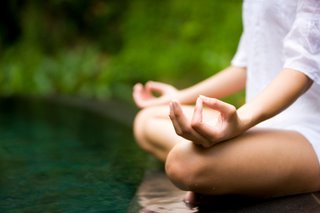 meditation timers with elegant soothing chimes The Zen Alarm Clock’s long-resonating Tibetan bell-like chime makes waking up a beautiful experience — its progressive chimes begin your day with grace. When the Clock’s alarm is triggered, the acoustic chime bar is struck just once … 3-1/2 minutes later it strikes again … chime strikes become more frequent over 10 minutes … eventually striking every 5 seconds until shut off (see the chime progression graph, below). As they become more frequent, the gentle chimes will always wake you up — your body really doesn’t need to be awakened harshly, with a Zen Clock you’re awakened more gradually and thus more naturally. $129.95
 meditation timers with elegant soothing chimes, real acoustic sounds Now & Zen
1638 Pearl St.
Boulder, CO 80302
(800) 779-6383
Posted in Chime Alarm Clocks, Zen Alarm Clock
 How to get that Elusive Good Night's Sleep - Tsukyoka Yoshitoshi 1888 Stanford’s Dr. Clete Kushida, president of the American Academy of Sleep Medicine, who has worked in the field of sleep research since 1977, offers these tips to a better night’s sleep:
Maintain a regular schedule, getting to bed and rising at the same time as consistently as possible each day, selecting the number of hours of sleep that make you feel best, whether it’s seven hours or 10.
Use bright light within five minutes of waking, for 30 minutes, to synchronize your internal clock.
Avoid bright light two to three hours before bedtime, which delays sleep onset. If you read, get just enough light to read and avoid halogen.
Avoid remaining in bed if you can’t sleep. After 20 minutes, if you can’t sleep or fall back asleep, go into another room and do something else until you feel drowsy.
Avoid reading or watching TV in bed (especially thriller novels or action shows) unless it makes you drowsy.
Avoid napping, unless you nap every day at the same time for the same amount of time or you are tired and about to get behind the wheel of a car.
One of the ultimate Zen like experiences is waking-up from a great slumber refreshed and energized. Your mind and body are harmoniously one, both alert and focused. Having a refreshed mind and body are two keys to a natural and Zen lifestyle. Waking up in the morning should not be a loud and abrupt awakening, but rather it should be a peaceful positive experience. The right natural alarm clock can transition your deep and tranquil sleep into a serene start to consciousness. Imagine a long-resonating Tibetan bell-like chime waking you up to a beautiful morning experience.
The right alarm clock can be the most beneficial investment for you. With our Now & Zen natural alarm clock you are awakened more gradually and thus more naturally. Now & Zen is focused on creating a naturalistic lifestyle, and our clocks are an example of our philosophy.
adapted from SFgate.com
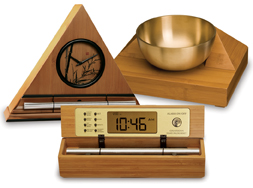 Waking up in the morning should be as pleasant as falling asleep at night. The Zen Alarm Clock's gradual, gentle awakening is transformative. Now & Zen’s Gradual Chime Alarm Clock Store
1638 Pearl Street
Boulder, CO 80302
(800) 779-6383
Posted in Chime Alarm Clocks, sleep, Sleep Habits, Zen Alarm Clock, Zen Timers
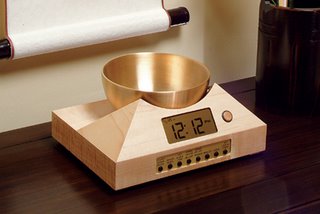 Zen Alarm Clock with Gradual Chime, No Snooze Buttons Allowed! The latest batch of high-tech alarm clocks explode, roll away, fly away and even make you solve math problems to keep you from oversleeping.
Our Zen Timepiece’s acoustic 6-inch brass bowl-gong clock is the world’s ultimate alarm clock, practice timer, and “mindfulness bell.” There are no gimmicky snooze buttons or sounds! When the clock’s alarm is triggered, the acoustic chime bar is struck just once … 3-1/2 minutes later it strikes again … chime strikes become more frequent over 10 minutes … eventually striking every 5 seconds until shut off. As they become more frequent, the gentle chimes will always wake you up – your body really doesn’t need to be awakened harshly, with a Zen Clock you’re awakened more gradually and thus more naturally. Unlike artificial recorded sounds coming out of a tiny speaker in a plastic box, natural acoustic sounds transform your bedroom or office environment.
It fills your environment with beautifully complex tones whenever it strikes. In the morning, its exquisite sounds summon your consciousness into awakening with a series of subtle gongs that provide an elegant beginning to your day. Once you experience the Zen Timepiece’s progressive awakening, you’ll never want to wake up any other way. It also serves as the perfect meditation timer. Available in 5 wood styles, including bamboo (not shown).
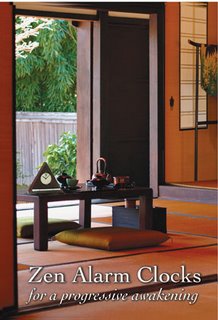 No Snooze Button Alarm Clocks, Zen Clocks Can Change Your Life
Now & Zen – The Zen Alarm Clock Store
1638 Pearl Street
Boulder, CO 80302
(800) 779-6383
Posted in Zen Alarm Clock, Zen Timepiece by Now & Zen, Zen Timers
 gentle awakening clock with acoustic chime Boulder, Colorado—an innovative company has taken one of life’s most unpleasant experiences (being startled awake by your alarm clock early Monday morning), and transformed it into something to actually look forward to. “The Zen Alarm Clock,” uses soothing acoustic chimes that awaken users gently and gradually, making waking up a real pleasure.
What makes this gentle awakening experience so exquisite is the sound of the natural acoustic chime, which has been tuned to produce the same tones as the tuning forks used by musical therapists. According to the product’s inventor, Steve McIntosh, “once you experience this way of being gradually awakened with beautiful acoustic tones, no other alarm clock will ever do.”
 sleeping woman using gentle awakening alarm clock Now & Zen – A Gradual
Alarm Clock Store
1638 Pearl Street
Boulder, CO 80302
(800) 779-6383
Posted in Bamboo Chime Clocks, Chime Alarm Clocks, Zen Alarm Clock
 zen and the art of waking up, alarm clocks by Now & Zen, Inc. Zen Clocks provide an exquisite waking experience with natural acoustic chimes or gongs—once you wake up with a Zen Alarm Clock, you’ll never want to wake up any other way! These beautiful products are also in high demand for use as meditation or yoga timers.
Now & Zen Headquarter Store
1638 Pearl Street
Boulder, CO 80302
(800) 779-6383
 zen and the art of waking up, chime alarm clocks by Now & Zen
Posted in Bamboo Chime Clocks, Natural Awakening, Zen Alarm Clock
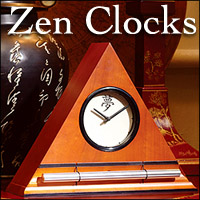 zen alarm clock As the temperature drops, your superficial venous circulation slows down, meaning your body has to work harder to get blood from your feet back to your heart. To help your venous circulatory system and keep varicose veins at bay, Dr. Luis Navarro of the Vein Treatment Center in New York City suggests getting your feet 6 to 12 inches above your heart at least once a day. Tonight, try a yoga pose that raises your legs against a wall, or lie on the couch with your feet resting on a stack of pillows. Cup of hot tea (or hot toddy) optional.
adapted from Wholeliving.com, Oct. 2011
Posted in Well-being, Zen Alarm Clock
 the link between sleeping and weight Not sleeping enough can do more than make you groggy the next day. It can also take a serious toll on your health—starting with your weight.
In the past several years, medical experts have confirmed a link between lack of sleep and weight problems, and a new study from the University of Chicago and the University of Wisconsin-Madison confirms this. Researchers conducted their study on two groups of overweight people. The first group slept for only five and a half hours each night, and the second group slept for eight and a half hours each night. The study found that while both groups lost weight, those who slept longer burned more fat, while those who slept less burned more muscle mass.
In an interview with NPR, sleep medicine expert Dr. Michael Lacey of the Atlanta Sleep Medicine Clinic explained that lack of sleep not only decreases metabolism, but also interferes with the body’s natural production of the hormones ghrelin and leptin, which regulate appetite and satiation. Too little sleep causes the body to produce too much ghrelin, which makes you feel hungry, and not enough leptin, which makes you feel satiated or full. Staying awake longer than you should will make you feel hungry when you’re really not, and will lead you to eat at times you normally wouldn’t. The longer you stay awake, the more tempted you’ll be to snack, too. To make matters worse, most people staying awake too long reach for high-carb or sugary foods, which they’re unlikely to burn off in the wee hours of the night.
Getting enough sleep will help your body burn fat and regulate weight. But how much is the right amount to get? Most sleep experts pinpoint seven to seven and a half hours as the magic sleep number. Sleep fewer than seven hours and you run the risk of fatigue and weight problems. Sleep too much and you put yourself at risk for cardiovascular disease.
adapted from Natural Home Magazine, October 2010 by Susan Melgren
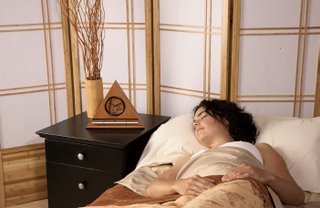 gentle alarm clock, for a slow wake-up
Now & Zen
1638 Pearl Street
Boulder, CO 80302
(800) 779-6383
Posted in Chime Alarm Clocks, sleep, Sleep Habits, wake up alarm clock, Well-being, Zen Alarm Clock
 yoga After a busy day of work, kids, groceries, and stressing over global warming weather conditions, how often do you sit down and think about how accomplished you are; how many people you’ve helped; how you know you can do it again tomorrow because you’ve truly got what it takes to change the world? Most likely you collapse in a heap on the couch, overwhelmed by feelings of struggle or ineffectiveness, negative self-image, inertia, or the everyday kitchen-sink blahs.
Yoga can help you through those doldrums. Like a piece of string tied around your finger, yoga serves as a reminder to acknowledge all the good things about yourself—those accomplishments and qualities you’ve somehow forgotten. It gives you the confidence and oomph you need to shift feeling states—all you need to do is roll out that yoga mat and get started. In fact, one of the first things that yoga will actually remind you about is to do yoga!
Those of us who practice yoga regularly—the precise postures, deep breathing, and meditative awareness—have learned that no matter what mood we’re in at the beginning of our yoga session, we always feel better by the end. If we start out feeling stiff, we become looser and more fluid. If we feel sluggish, our energy perks up. If we were hyper-stimulated when we first sat on our mat, we end up calmer and more balanced when we leave. On days when we’re overwhelmed, yoga brings a sense of grounding and connection. When distressing world events lead to feelings of helplessness, the strength we exert on the mat will help us tap into a sense of personal power that allows us to move forward in life. Instead of feeling pulled in all directions, we begin to feel connected to ourselves.
Yoga works like this every time, no matter what reason you have for doing (or starting) it. Getting in shape, gaining strength and flexibility, improving your posture, digestion, or sex life—all these good things are already within your grasp. That strong, fluid, healthy, sexy you is just waiting to be uncovered, just longing for an invitation to show up at the party. Yoga serves as a reminder that the strong, able, open-hearted, and confident person you wish to be already exists, at least on the inside.
I’ve had plenty of intimidating experiences that yoga rescued me from, such as the time I gave a yoga lesson to a regular private client—an upper-crust member of high society—and her guest from the British royal family decided to join in. If I had been introduced to him before the class, I’m sure my palms would have started sweating, and I would have done a Ralph Kramden, “A hummuna hummuna.” But the class was already in full swing and, filled with confidence about the benefits of yoga, I didn’t feel the least bit shy as I warmly welcomed him onto the mat.
As I made some hands-on adjustments to the now shirtless royal, I thought to myself, “Is it OK to touch someone this close to the crown?” But, at that moment, I was the expert and I knew that I could help him with his overly flexible joints. He couldn’t have been nicer and more appreciative, and we had a nice chat after the class, during which I wished I were wearing a cuter outfit.
Even though I wasn’t doing the yoga with my two students, I benefited from exploring the qualities that they were practicing under my guidance: standing on one’s own two feet, finding balance, resting in one’s breath, taking chances, being steady and straightforward, letting go, falling down, having fun, and taking a fresh start. These are all yogic gateways toward remembering the feeling of confidence in any situation.
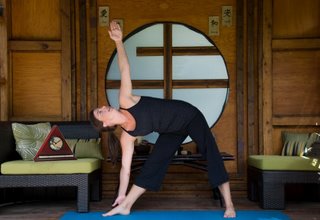 yoga Meditation master Chogyam Trungpa taught that we are all born with basic goodness, and when we acknowledge this, we connect with a sense of primordial confidence. Although this confidence already lives within us, we can sometimes lose our link to it because of negative emotions, such as fear, jealousy, or hatred. Alas, those feelings live there, too, but they don’t have to take over our entire mental and emotional landscape, leaving no room for the natural faith we have in who we are and what we can do. Just like in cooking, we can fold our natural self-confidence right into our self-consciousness to create a new and healthier blend. Who knows? Maybe with enough yoga practice, the confidence will rise to the top just like the yummy cream in a farm-fresh bottle of milk.
This yoga sequence is designed to help you develop building blocks you can use to reconnect to your own inherent self-confidence. Take your time, and try to release any expectations. The opposite of self-confidence is wishing and hoping, which always get us in trouble. Let go of that habit, and try to stay connected to your own deep breath. Have faith in your own good heart.
Mountain Pose With Arms Up. Stand with your feet directly below your sitting bones so you feel firmly planted. At the same time, actively reach through every fingertip up to the sky. This pose can be done almost anywhere, anytime, and is a great reminder of how good it feels to be able to stand on your own two feet. Let your breath be full and notice how your front, back, and sides fill with breath and soften back in toward your strong and quiet center. Hold this position for five deep breaths.
Warrior Lunge. Bend both knees. Step your left foot back, and balance on the ball of the foot. Make sure your left leg is straight with strong energy extending out your left heel. Keep your right leg parallel to the ground, knee above heel. Use your abs to keep your spine vertical. Even though your arms are getting tired, hold them up with commitment for a little longer. Let your gaze rest on something at eye level across the room to help you find balance and steadiness within the exertion of this full-body position. Stay here for three to five breaths.
Open Warrior (Warrior 2). On an exhale, turn your back heel inward and lower it to the ground, so your left foot is roughly perpendicular to your right, and the arch of your left foot is in line with the heel of your right. Pivot your hips and torso to face outward over your left foot. Extend your arms away from each other at shoulder height. As you breathe in and out for five to eight breaths, let your open body position invite you to feel expansive, open-hearted, and confident.
Reverse Warrior 2. On an inhale, lean away from your bent knee, stretching your right arm overhead as your left hand rests on your left thigh for support. Stay here for three breaths and indulge in the feeling of breath nourishing your body. Even though your legs are getting tired, can you let your breath give you a second wind? This is great practice for staying the course when you feel tired or discouraged.
Lunge. On an exhale, cartwheel your hands to the floor, on either side of your right foot. Bring your left knee to the ground with your toes pointing behind you, in line with your body. Your right knee should be over your right heel. Reach out through the crown of your head and out through your back heel. Focus on your whole body, inhaling and exhaling through your nose for five cycles.
Twisted Lunge. On an exhale, twist to the right and place your hands in prayer position. Press the back of your left elbow against the outside of your right knee as you draw up through your spine. Relax your mind once again and see if you can feel long, strong, and expansive. Stay here for 5 breaths. Lengthen your spine with each inhale, and twist a little bit more deeply (from your core) with each exhale.
Forward Fold. Exhale and place your hands on the floor on either side of your right foot. Inhale; on the next exhale, step your back foot forward and place it next to your right foot. Let your head hang between your arms and bend your knees if it’s more comfortable. Stay here for as long as you want but try to focus on your breath. Notice what the breath feels like when you are in this upside-down situation. It will be helpful when life throws you for a loop.
adapted from Natural Solutions by Cyndi Lee
Use our unique “Zen Clock” which functions as a Yoga Timer. It features a long-resonating acoustic chime that brings your meditation or yoga session to a gradual close, preserving the environment of stillness while also acting as an effective time signal. Our Yoga Timer & Clock can be programmed to chime at the end of the meditation or yoga session or periodically throughout the session as a kind of sonic yantra. The beauty and functionality of the Zen Clock/Timer makes it a meditation tool that can actually help you “make time” for meditation in your life. Bring yourself back to balance.
 Zen Alarm Clocks and Yoga Timers with Gentle Chime Now & Zen – The Yoga Timer Store
1638 Pearl Street
Boulder, CO 80302
(800) 779-6383
Posted in Yoga Timer, Yoga Timers by Now & Zen, Zen Alarm Clock, Zen Gardens
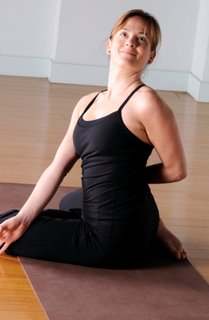 yoga There is one yogic breathing technique that can be practiced at all times of the day and night by just about anyone. This pranayama (breath control) is called ujjayi.
Ujjayi means “victorious.” The prefix ud means upward and superior, and jaya (from root ji) means to conquer and have victory over. With consistent practice of ujjayi breath, a practitioner will attain victorious results for both body and mind.
The benefits of ujjayi breath are manifold. In addition to aerating the lungs and removing excess phlegm, it boosts endurance and gently warms the body. This soothing breath massages and tones the entire nervous system, making it an excellent way to combat stress. It’s also believed to help counter high blood pressure.
While one should initially learn ujjayi breath in a seated position, in can later be consistently threaded through the entire asana practice.
Here’s how to practice:
1. Sit in a comfortable, upright meditation position (I encourage sitting on a folded blanket or pillow for extra support)
2. Maintaining a tall spine, close eyes and begin to breath normally through both nostrils. Observe the flow of the air in and out of the body.
3. Once you’re familiar with the course of the breath, take a deep, slow breath in through the nostrils. Try to focus the air in on the palate and back of the throat and create a sibilant sound (saaaa). It should be an ocean like sound, or like having your ear against a conch shell. Fill the lungs entirely and then…
4. Breath out slowly, focusing the air on the back of the throat/palate.
The sea-like sound is caused by a subtle constriction of the glottis, which is the aperture of the larynx.
The breath should be just loud enough that someone sitting close to you would hear it. Avoid being too loud of forceful. I’m fond of esteemed Ashtanga teacher Tim Miller’s description of ujjayi, “Imagine sipping the breath in through a straw. If the suction is too strong the straw collapses and great force is required to suck anything through it.”
5. Set your Zen Timer with Tibetan Bowl for 15 minutes. Continue to breathe for 5 to 15 minutes with this ocean like sound. If possible, take a brief savasana after.
More experienced practitioners, commit to carrying ujjayi breath through your entire asana practice. Let it be metronomic in quality.
Observe how much space you’ll discover in body and mind!
Sophie Herbert is an alignment focused yoga teacher (and perpetual student), a singer-songwriter, and a visual artist. She has lived, studied, and volunteered extensively in India; teaches yoga in Brooklyn and Manhattan; and recently released her first full-length album, “Take a Clear Look.” Please visit her website at SophieHerbert.com.
adapted from Wholeliving.com February 2011
Use our unique “Zen Clock” which functions as a Yoga Timer. It features a long-resonating acoustic chime that brings your meditation or yoga session to a gradual close, preserving the environment of stillness while also acting as an effective time signal. Our Yoga Timer & Clock can be programmed to chime at the end of the meditation or yoga session or periodically throughout the session as a kind of sonic yantra. The beauty and functionality of the Zen Clock/Timer makes it a meditation tool that can actually help you “make time” for meditation in your life. Bring yourself back to balance.
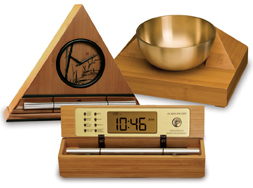 The Zen Timer and Clock Store - Boulder, Colorado Now & Zen – The Zen Timer Store
1638 Pearl Street
Boulder, CO 80302
(800) 779-6383
Posted in Chime Alarm Clocks, yoga, Yoga Timer, Yoga Timers by Now & Zen, zen, Zen Alarm Clock, Zen Clocks and Dream Recall, Zen Timers
 When less is more Make more time for doing the things you love by simplifying your life.
Judy Davis never buys anything new if she can help it. A 58-year-old freelance marketing consultant who lives in Red Bluff, California, she favors thrift store clothing and secondhand furniture. Instead of buying gifts, she gives plants from her garden or bags she has sewn from cut-up vintage gowns. Judy is part of a Bay Area group called the Compact. The Compacters have vowed not to buy anything new for a year except bare essentials: food, medicine, cleaning products, and underwear (although not, of course, lingerie from Paris). Although few people take frugality quite as seriously as the Compacters do, more and more of us are voluntarily cutting back on buying and consumption. Many individuals choosing this lifestyle happen to be yogis. The seminal work of yoga philosophy, Patanjali’s Yoga Sutra, frowns on materialism, and some yogis find that their asana practice alone helps them be happier with less.
The pursuit of the simple life is nothing new, of course. From Quakers to Transcendentalists, America has always had its share of those who associate simplicity with spiritual growth. Back-to-the-land hippies of the ’60s and ’70s found simplicity appealing for more secular reasons, such as ecological sustainability. But those who practice pared-down living today are not necessarily spiritual ascetics or off-the-grid granola types. Most are ordinary people modifying their everyday behavior-trying to be conscious about what they eat, drive, and buy.
In the past 15 years, “voluntary simplicity,” as it is called, has gained thousands of converts. Many books on the subject have been published, such as Janet Luhrs’s The Simple Living Guide, Cecile Andrews’s Circle of Simplicity: Return to the Good Life, and Linda Breen Pierce’s Choosing Simplicity: Real People Finding Peace and Fulfillment in a Complex World. Dozens of websites have sprung up, and nonprofits like Seeds of Simplicity and Simple Living America champion the cause. When the Compacters publicized their manifesto in January 2006, their Yahoo group swelled from about 50 in February to 1,225 in July, with members across America.
Most spiritual traditions encourage simple living, and yoga is no exception. In the Yoga Sutra, Patanjali laid out the yamas (moral restraints) and niyamas (observances), a set of 10 principles that are crucial to one’s progress along the yogic path. One of the yamas is aparigraha, often translated as “greedlessness.” But it means more than just taking only what you need, explains David Frawley, founder and director of the American Institute of Vedic Studies and author of Yoga and the Sacred Fire. Aparigraha also means “not having a lot of unnecessary things around yourself and not hankering after what other people have,” Frawley says. In other words, aparigraha also means keeping only what you need and wanting only what you need.
Aparigraha leads naturally to one of the niyamas: santosha, or “contentment,” being satisfied with the resources at hand and not desiring more. Ultimately, Frawley says, “Yoga is about transcending the desire for external things, which is the cause of suffering, and finding peace and happiness within.”
adapted from Yoga Journal, by Helena Echlin
 Zen Alarm Clocks Now & Zen
1638 Pearl Street
Boulder, CO 80302
(800) 779-6383
Posted in intention, Meditation Timers, Meditation Tools, mindfulness practice, Now & Zen Alarm Clocks, Well-being, zen, Zen Alarm Clock, Zen Timers
« Previous Page — « Previous Entries
Next Entries » — Next Page »
|
|
|
|